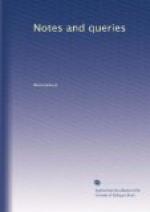QUERIES.
QUERIES ON OUTLINE.
The boundary between a surface represented and its background received two different treatments in the hands of artists who have the highest claims on our respect. Some, following the older painters as they were followed by Raphael and Albert Durer, bring the surface of the figure abruptly against its background. Others, like Murillo and Titian, melt the one into the other, so that no pencil could trace the absolute limit of either. Curiously enough, though for very obvious reasons, the Daguerreotype seems to favour one method, the Calotype the other. Yet, two Calotypes, in which the outlines are quite undefined, coalesce in the Stereoscope, giving a sharp outline; and as soon as the mind has been thus taught to expect a relievo, either eye will see it.
But if you look at your face in the glass, you cannot at once (say at three feet distance) see the outlines of the eye and cheek. They disappear every where, except in the focus common to both eyes. Then nothing is seen absolutely at rest. The act of breathing imparts perpetual motion to the artist and the model. The aspen leaf is trembling in the stillest air. Whatever difference of opinion may exist as to Turner’s use or abuse of his great faculties, no one will doubt that he has never been excelled in the art of giving space and relative distance to all parts of his canvas. Certainly no one ever carried confusion of outline in every part not supposed to be in the focus of the eye so far.
On the other hand, every portion of a large picture, however severe its execution, acquires this morbid outline wherever the eye quits one detail for another. Is, then, the law governing small and large surface different? Do these instances imply that a definite boundary, a modern German style, is indefensible? or only indefensible in miniature? Or, is such a picture as the Van Eyh in the National Gallery a vindication of the practice in small works?
I can answer that it is not; and this last question I merely ask to avoid all answers on the score of authority. No doubt that strange work is one of the most realising pictures ever painted,—more so than any neighbouring Rembrandt,—whose masses of light and shade were used as a “creative power.” I want to know whether there is a right and wrong in the case, apart from every thing men call taste. Whether, whenever a work of art passes from suggestion to imitation, some liberty must not be given at the lines whence the rays are supposed to diverge to the two eyes from two different surfaces. Every advance in art and science removes something from the realms of opinion, and this appears to be a question on which science must some day legislate for art.
J.O.W.H.
* * * * *
CHRIST’S HOSPITAL—OLD SONGS ONCE POPULAR THERE.




